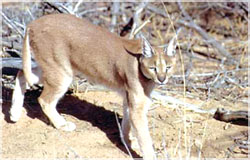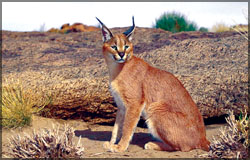Nature trail
Felines: small, wild and beautiful - VII:
Big eared hunters
The two small wild cats we feature today are rather unusual in
appearance in comparison to the other members of the cat family, because
they both have ears which are very large.
If anyone of their prey were to ask these wild cats "why do you have
such big ears" the reply. They would give, like the wolf in Red Riding
Hood, would be "all the better to hear you". They certainly use their
huge ears to listen to the movements of their prey.
Caracal
|

Fastest and heaviest among small cats. |
Often referred to as the Persian lynx or the African lynx, the
caracal is labelled as a small cat even though it seems big in
appearance. At one time it was believed that the caracal is a close
relative of the lynx, but recent DNA research had revealed that it is
not so. The caracal is in fact a relative of the serval and the African
golden cat.
The caracal is the fastest and heaviest among the small cats. The
average weight of a male is between 13-18 kg (25-5- lbs) while the
female is generally smaller. It has an average body length of 65 cm (2
ft) and a tail that is about 30 cm (a foot) long. It has a body which is
slender than that of a lynx and longer legs. Its coat colour varies from
wine-red to grey and sand colour.
Melanistic (black) caracals are not uncommon. Young caracals bear red
spots on the underside, but adults don't display any markings on the
body except for black markings alongside the eyes. It has a tapering
tail and dense, short fur. The underparts of the chin and body are
white. Narrow, black lines run from the corner of the eyes to the nose.
 The most conspicuous (striking) feature is the ears which are long,
narrow and tipped with long, black tufts of hair. The most conspicuous (striking) feature is the ears which are long,
narrow and tipped with long, black tufts of hair.
In fact, its ears which are black on the rear have led to its name
karakulak in Turkish, which literally means 'black ear'. It has been
found that 20 different muscles control its ears to help find prey. The
tufts of fur on the tip are said to pinpoint prey when hunting. It has
good vision too. Its pupils contract to form a circle rather than a slit
found in most other cats.
A skilful and agile hunter, the caracal captures its prey after
stalking them first and then dashing after them or leaping on them.
Strictly carnivorous, it hunts mostly at night and during the day in
colder seasons.
Rodents, birds, rock squirrels and hyraxes are hunted. Sometimes it
attempts to catch small antelope, gazelle or young ostriches. It also
preys upon poultry and as a result has become very unpopular among
farmers.
|

Twenty muscles control its ears. |
The caracal is considered to be a picky eater, because, it generally
discards the internal organs of its prey and also avoids eating any
hair; it normally shears meat neatly from the skin.
However, it's tolerant of rotten meat and eats feathers of small
birds. It is said to be highly skilled at catching birds. Since it could
climb and jump exceptionally well, the caracal is able to catch birds in
flight. In fact, it can snatch more than one bird at a time.
It can survive without drinking water for long periods of time
because it obtains the necessary fluids from the body fluids of its
prey. Distributed over Africa and Western Asia, it is at home in a
number of habitats such as dry steppes, semi-deserts, woodlands, the
savannah and scrub forests.
Capable of breeading all year round, the female gives birth to a
litter of 1-6 kittens after a gestation period of 71 days approximately.
The kittens which are a bright, reddish-brown, with reddish spots on the
underside, are born blind and open their eyes only after about 9-10
days.
The litter is hidden in abandoned burrows, ant or bear holes, rock
crevices or in hollows of trees. The kittens gain 21 g per day and are
weaned of mother's milk by 10-25 weeks. They are totally independent by
about 12 months.
 The caracal which is mostly a nocturnal animal is very territorial.
It is classed as a solitary or paired territorial cat which is rather
difficult to spot in the wild because it stays in hiding most of the
time. Seven of the sub species named could be found in the African
continent while only two could be spotted in the Asian part of the
region the cat population is normally distributed in. The caracal which is mostly a nocturnal animal is very territorial.
It is classed as a solitary or paired territorial cat which is rather
difficult to spot in the wild because it stays in hiding most of the
time. Seven of the sub species named could be found in the African
continent while only two could be spotted in the Asian part of the
region the cat population is normally distributed in.
In the wild, the cat is known to survive for about 12 years, but in
captivity it lives for about 17 years. It is easy to tame and is being
used as a hunting cat in Iran and India. Sometimes it is kept as a pet
because it adapts easily to life with humans.
When cornered, the caracal could turn fierce and become dangerous
even to humans.
When pursued by wild dogs in its habitat, it generally flees and
climbs a tree.
Serval
 This cat is considered unique among the members of the cat or felids
family because of its unusual shape. It has a long neck, small head and
over-sized oval shaped ears set close together. This cat is considered unique among the members of the cat or felids
family because of its unusual shape. It has a long neck, small head and
over-sized oval shaped ears set close together.
Its slender, long legs and long neck enable it to see over the tall
grasses. Its huge ears are used to detect prey, even rodents burrowing
underground. Compared to its body size, the serval has the longest legs
among cats. Even when it stretches out on the ground, it normally does
so, canine style.
This medium-sized African cat is closely related to the caracal and
African golden cat. It is 85 cm (34 in) in length and has a fairly short
tail which is about 40 cm (16 in) long. At shoulder height, it reaches
53 cm (21 in). It weighs between 9-20 kg (20-44 lbs).
Its golden coat is marked with black spots, freckles and stripes.
Melanism (black coats) are known to exist in sub species, giving it a
similar appearance to the black panther. White servals with silver-grey
spots have been reported to have occurred in captivity. The Savannah cat
has been bred with the crossing of a serval with a domestic cat.
|

Its huge ears are used to detect prey |
An opportunistic predator, the serval hunts rodents, fares, hyraxes,
birds, reptiles, insects, fish and frogs. It has also been observed to
hunt larger animals such as small antelopes.
It's known to eat its food very quickly, sometimes leading to
regurgitation because of clogging of the throat.
|

Itís shaped differently to other small cats. |
The sevral is said to be a skilful hunter, achieving 50 per cent
success at catching its prey. It has been observed that the serval uses
its over-sized ears to the maximum when hunting. Researchers say when
hunting, that the serval pauses for about 15 minutes to listen, with its
eyes closed. Once it locates the prey, it pounces with a distinctive
vertical hop.
After a gestation period of 66-77 days, the female gives birth to a
litter of 2-3 kittens. Sometimes the number of kittens can be as few as
one or as many as five. They are normally raised in a sheltered
location. If such a safe place cannot be found, the mother hides them
behind a shrub. Its enemies are leopards and other big cats in the wild,
but humans are actually the most dangerous enemies it has. Servals are
extensively hunted for their fur.
Of the exotic felines, the serval is known to have the most
affectionate personality. It is a good companion animal and like many of
their domestic cousins, love to share the bed with their owners.
|

Servals, when cept as pets, enjoy going for rides and walks. |
The serval also enjoys rides in cars and walks on a leash which are
certainly not something pet cats seem to enjoy. They are definitely
things our canine pets normally like to do.
In captivity it has been known to survive for 17-20 years, but it is
not easy for everyone to rear a serval because it needs an abundance of
special care. So, even if you and I would love to have such an exotic
creature to take for rides in a vehicle or for a walk on a leash, the
way most people do with their canine companions, we would not be able to
do so, simply due to lack of funds and time to give it that extra
special care. |
